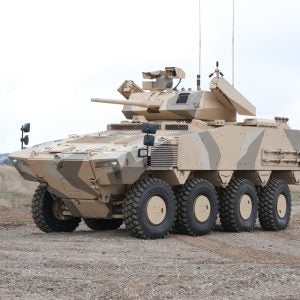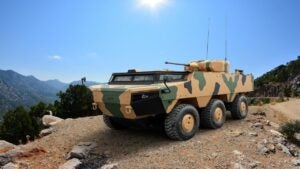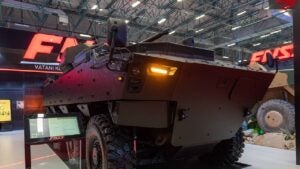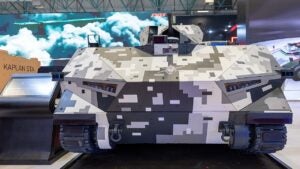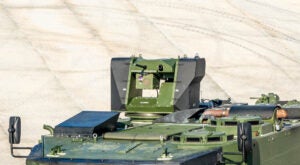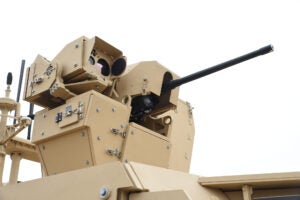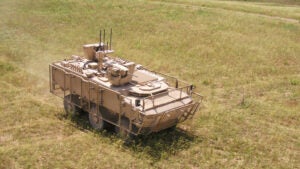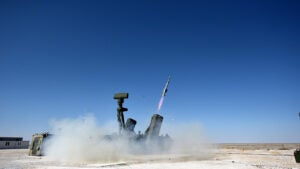FNSS Showcases PARS 6×6 Armoured Fire Support Vehicle, 30mm Lightweight RCT & ACV Life Extension Solution at DSA 2024
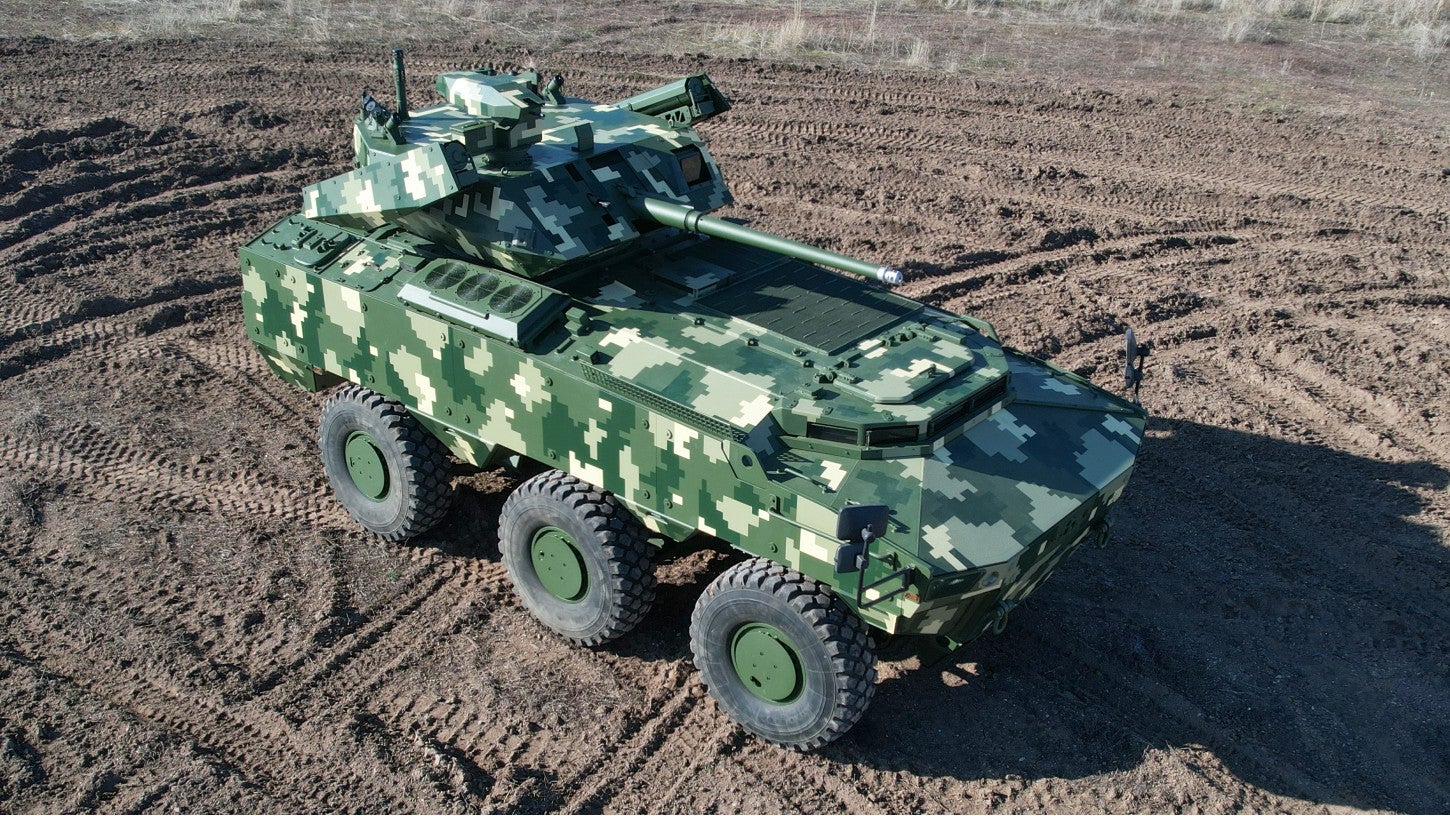
FNSS will exhibit the PARS III 6×6 vehicle equipped with the TEBER-II 30/40 Remote Controlled Turret (RCT) alongside the SANCAK 30mm Remote Controlled Turret, at the DSA 2024 Exhibition in Malaysia. From May 6 to 9, FNSS will welcome visitors at stand number 2100C in Hall 2, situated within the Turkish pavilion at the Malaysia International Trade and Exhibition Center. As part of efforts for extending the lifecycle of the Malaysian Army ACV-15’s, a prototype of ADNAN AIFV modernised by DEFTECH and FNSS will be exhibited in the DEFTECH stand at the same Hall.
SANCAK 30mm RCT (Remote Controlled Turret)
FNSS’ SANCAK 30mm RCT, integrated onto PARS 4×4, was first unveiled at IDEF 2023. It is a derivative of SANCAK RCT which is designed to accommodate various weapons, including the M2 12.7mm/.50 calibre machine gun, Mk19 40mm automatic grenade launcher, M240 7.62 machine gun, and FN MAG58 7.62mm machine gun, thanks to its universal weapon mount. SANCAK 30 RCT, carrying a lightweight, low recoil VENOM LR 30x113mm autocannon with enhanced firepower, is now being showcased at the DSA 2024 FNSS booth. Firing various types of 30x113mm ammunition, VENOM LR produced by AEI Systems proves effective against infantry in the open and behind cover as well as against fortified positions, soft-skinned targets, lightly armoured vehicles and drones. SANCAK 30 RCT, equipped with 2-axis stabilization and target tracking systems as well as ballistic protection, therefore provides the necessary firepower to tactical armoured vehicles with high mobility, operating both in open and urbanized terrain.
SANCAK RCT, developed by FNSS as part of the PARS III 8×8 and 6×6 export project, initially became operational within the inventory of the Royal Army of Oman. It was subsequently delivered to Turkish Armed Forces in November 2022, serving as the main firepower of the PARS IV 6×6 Special Operations Vehicle under the 6×6 SSB Mine Resistant Vehicle Supply Project.
This new 30mm configuration is offered to new users both domestically and internationally.
PARS III 6×6 Armoured Fire Support Vehicle
With a maximum combat weight of 25,000 kg, the PARS III 6×6 Armoured Fire Support Vehicle is powered by a diesel engine. Capable of reaching speeds of up to 100 km/h, the vehicle can manoeuvre on a 60% vertical slope and a 30% side slope, climb 0.7 meters high obstacles, and cross 1.75 meters wide trenches.
Thanks to its engine layout and balanced design, the vehicle maintains evenly distributed axle loads. This design feature facilitates smooth navigation, even on loose or soft ground, ensuring control at high speeds and short braking distances. Moreover, the differentials on each axle can be locked as needed. Additionally, the central tyre inflation system allows the driver to adjust tyre pressures based on diverse terrain conditions.
The power pack architecture of the PARS III 6×6 vehicle, capable of being removed and installed in less than 60 minutes, represents a notable feature that provides users with ease of maintenance, repair, and engine replacement directly in the field.
The fully independent hydropneumatic suspension system, offering the highest wheel travel in its class, provides the PARS III 6×6 Armoured Fire Support Vehicle with exceptional handling across the country or hard surface roads. Enhanced by a first and third-axle steering system, it boasts the smallest turning radius in its class. Additional safety features, including the ability to lock the steering system on the third axle at high speeds, the ABS system, and the engine brake, further elevate the vehicle’s driving safety.
The vehicle can accommodate up to nine personnel together with their equipment are designed to ensure exceptional payload capacity and drive comfort.
With a range of over 800 km, the PARS III 6×6 Armoured Fire Support Vehicle is equipped with fuel tanks featuring special precautions against explosions and punctures. Additionally, a spare fuel tank is located under the armour for emergency use. Run flats placed inside the wheels enable the vehicle to continue travelling even with flat tyres.
The hull of the PARS III 6×6 can be tailored to the desired level of protection thanks to its modular armour systems. Specifically, designed hull form, underbelly structure, base plates, and mine-protected seats provide enhanced protection against high-level of mine threats for the personnel.
The air conditioning system integrated into the PARS III 6×6 offers significant advantages to its users. One notable distinction from its counterparts is its ability to maintain the vehicle’s indoor temperature at +25°C, even in tropical climates. The vehicle is equipped with a 30mm TEBER-II Remote Controlled Turret (RCT) designed by FNSS.
TEBER-II 30/40 Remote Controlled Turret (RCT)
The turret is equipped with a 30mm dual-feed automatic cannon. The existing 30mm gun barrel can be replaced with a 40mm barrel while preserving the main components and the stock. This adaptable weapon system option enables users to enhance firepower easily and as required. Additionally, a 7.62mm coaxial machine gun is mounted alongside the main gun.
Various anti-tank missile systems can also be seamlessly integrated into the TEBER-II 30/40 RCT system. Two ready-to-fire anti-tank missiles are supported by a fire control system integrated into the turret. This capability enables the vehicle to effectively engage a wide range of threats at distances exceeding four kilometres.
The turret is equipped with an independent remote-controlled weapon system (RCWS) that can adjust firing angles both upwards and downwards. The elevation angle of this system, which is compatible with either a 7.62mm or 5.56mm machine gun, is effective against threats positioned at elevated points (such as buildings, rooftops, etc.) in urban environments, as well as drones approaching from high angles. Additionally, this system can function as the commander’s independent sighting system for ‘hunter-killer’ capabilities.
In addition to the TEBER-II 30/40 RCT, the vehicle can also be equipped with manned or remotely controlled turrets featuring a range of armaments, including 7.62mm and 12.7mm machine guns, 25mm and 35mm automatic cannons, 40mm automatic grenade launchers, 90mm cannons, and various types of anti-tank systems.
The PARS III 6×6 Armoured Fire Support Vehicle stands out for providing the protection level of mine-protected vehicles used for personnel transport while also incorporating the capabilities expected from a modern armoured combat vehicle.
The PARS III 6×6 Armoured Fire Support Vehicle is transportable by land, air (A400 M transport aircraft), sea, highways and railways.
FNSS Modernisation Programmes & ACV-15 ADNAN Enhancement & Life Extension Solution
ACV modernization programs cover upgrade areas such as improvements in mobility, protection, life support systems, mission equipment, situational awareness and firepower. Within the scope of the capability enhancement program, the vehicles are being fitted with a new generation remote-controlled weapon system with a close-range surveillance system, auxiliary power unit, A/C system, automatic fire suppression system, spall liners, driver vision system and navigation system.
In addition, necessary engineering efforts are being carried out to integrate the gunshot detection system. Under the modernisation programmes, a complete vehicle overhaul, including the replacement of engine and transmission, is also taking place. All these improvements in reliability and durability aim to increase mission capabilities while minimising maintenance services during operational deployments.
FNSS has a history of success stories, completing modernisation programmes for over 3000 vehicles in total for different armies such as Türkiye, the Kingdom of Saudi Arabia, the USA, Bahrain, and The Philippines. As the OEM for the ACV family of vehicles, together with experience and knowledge in new-generation vehicle development and modernization, FNSS offers the most advanced solutions for enhancement, life extension and sustainability programs based on user requirements. The company recently started deliveries of modernized ACV-15T1 IFV platforms to the Turkish Army under the scope of ACV-15T1 capability enhancement and life extension programme contracts. Follow-up modernisation contracts have also been awarded to FNSS as the prime contractor for the modernisation and life extension of ACV-15 Advanced Armoured Personnel Carriers by the Turkish Army.
As part of efforts to modernize the ADNAN ACV vehicles in the inventory of the Malaysian Army, one unit of the ADNAN ACV-15 IFV25mm vehicle, delivered by the Malaysian Army, was modernized as a prototype by DEFTECH and FNSS. Following the modernization, the vehicle underwent a two-week testing period by the Malaysian Army test team, successfully completing all user tests. The main objective of the modernization project is to improve the mobility and automotive functions, communication and combat management systems, and firepower functions of the vehicle at optimal costs.
During the modernisation process, the engine and transmission systems were maintained, repaired, and renewed. Depending on the user’s requirement, a new power pack option is also available within the modernization scope. Additionally, all the listed subsystems were improved through the integration of new subsystems equipped with modern technology.
• 25mm Turret and Fire Power
• Battle Management Systems (BMS)
• Fire Suppression Systems (FSS)
• Laser Warning Systems (LWS)
• Communication Systems
• Climate Control Systems (A/C)
• Electrical/Electronic Systems
• Driver Vision Enhancement Systems (DVE)
• 360° Situational Awareness System
As a result of all modernisation and improvement efforts, the existing capabilities of the ADNAN ACV vehicle were maintained. At the same time, new technology-equipped subsystems were added, providing both new capabilities and increased capacity for existing systems. In this context, the aim is to extend the vehicle’s service life by at least 20 years and to target shorter processing times for maintenance and repair services.
FNSS’ capability enhancement & life extension solution represents significant upgrades to an already proven and reliable military platform by extending the service life of the vehicles and ensuring that the vehicles remain an effective and relevant asset as a force multiplier for modern combat requirements.


